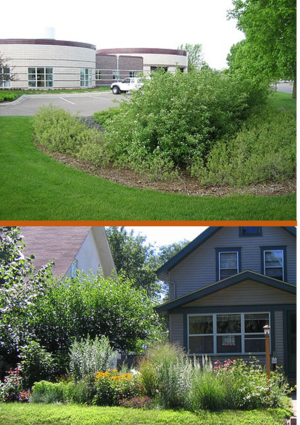
Wildlife habitat and biodiversity benefits of Green Stormwater Infrastructure
this page is in development
Vegetated stormwater practices (bioretention, tree trenches/boxes, green roofs, vegetated swales, constructed ponds and wetlands) can be designed, constructed, and maintained to enhance biodiversity at the micro (site) scale. Effects are most pronounced for invertebrate species. Improved ecological function results in greater delivery of ecosystem services, including infiltration of water, nutrient cycling and storage, and pollination.
Contents
Bioretention
Kazemi et al. (2009) studied 12 bioretention basins and observed "that greater leaf/plant litter depth or a combination of greater leaf/plant litter depth and larger number of plant taxa is a significant contributor to biodiversity in bioretention basins ... The distribution pattern of invertebrates within the systems increased from the edges towards the centre suggesting that designing the sites should consider shape and size to create larger interior habitats for enhancing biodiversity". The researchers observed that habitat improved with time, possibly to the extent that greater time allows for establishment of invertebrate species. The researchers summarize invertebrates identified. Mehring et al. (2016) also provide detailed information on the distribution of invertebrates in bioretention systems, including factors affecting distribution. They observed that soil organic matter content was an important factor affecting invertebrates, particularly earthworms.
Further study is needed to determine how biodiversity in bioretention systems compares to larger green spaces, such as urban parks and woodlands, although Mehring et al. (2016) observed that nitrogen storage and gas emissions were low in bioretention systems. However, Kazemi et al (2009) observed the number of species, species richness, and diversity displayed a decreasing trend from bioretenion basins to gardened and lawn-type greenspaces. The main habitat factors affecting invertebrate communities were vegetation, pH, leaf litter depth, and gravel.
- Additional recommend reading:
- - Optimization of bioretention systems through application of ecological theory
- - Soil invertebrates in Australian rain gardens and their potential roles in storage and processing of nitrogen
- - Factors affecting terrestrial invertebrate diversity in bioretention basins in an Australian urban environment
- - Streetscale bioretention basins in Melbourne and their effect on local biodiversity
- - Potential roles of soil fauna in improving the efficiency of rain gardens used as natural stormwater treatment systems
- - Gardening for Wildlife: Corralling the Rain - Rain gardens offer a natural solution to runoff pollution
Constructed Ponds and Wetlands
Clarke (2014) provided a review and analysis of factors affecting biodiversity of constructed stormwater wetlands along roads in Sweden. Factors having important impacts on biodiversity included salinity; pond size and shape; vegetation; nitrogen oxide concentrations; noise; contaminant concentrations (e.g. PAHs, heavy metals); pond age; pond type; and species. He observed biodiversity increased in the short-term, peaked and then decreased as heavy metal accumulations become lethal. Clay based ponds seemed to support the highest biodiversity, with PEHD bases slightly negatively correlated and concrete bases very negatively correlated with biodiversity.
Hassall and Anderson (2014) compared macroinvertebrate populations in wetlands receiving stormwater runoff and not receiving runoff. Although water chemistry differed significantly between wetlands receiving stormwater runoff or not receiving runoff, biodiversity in the richest wetlands receiving runoff matched biodiversity in the wetlands not receiving runoff.
Le viol et al. (2009) compared macroinvertebrate populations in ponds receiving highway runoff with other ponds. They observed that highway ponds "supported aquatic macroinvertebrate communities at least as rich and diverse at the family level as surrounding ponds and exhibited similar variability in family community composition and structure. The main difference we observed was a higher abundance of small and/or short-lived invertebrates in the highway ponds. These similar community compositions and structures suggest that highway ponds contribute to the biodiversity of the pond network at a regional scale."
Scher et al. (2004) "found significant differences in macrophyte species richness ... linked to the bottom type of the pond. As regards to amphibians, these stormwater ponds were largely colonised by opportunistic and anthropophilous species."
- http://www.christopherhassall.com/wp-content/uploads/2013/01/FBA_NEWS_64_AutumnWinter2014_2015_compressed-CH-only.pdf
- http://publications.lib.chalmers.se/records/fulltext/202975/202975.pdf
- http://www.sciencedirect.com/science/article/pii/S1470160X1100080X
- http://www.sciencedirect.com/science/article/pii/S0925857412002303
- https://link.springer.com/article/10.1007%2Fs10750-005-4464-z?LI=true
- http://www.sciencedirect.com/science/article/pii/S004313541100710X
- http://onlinelibrary.wiley.com/doi/10.1002/wat2.1014/full
Green roofs
- http://www.urbanhabitats.org/v04n01/introduction.html
- https://livingroofs.org/biodiversity-and-wildlife/
- http://onlinelibrary.wiley.com/doi/10.1111/1365-2664.12333/full
- http://blog.green-urbanscape.com/blog/green-roof-a-potential-new-habitat-for-plants-and-animals-in-urban-areas
- http://www.greenroof.hrt.msu.edu/research-projects/wildlife-habitat-relationships.html
- http://www.greenrooftechnology.com/biodiversity
Vegetated swales
Tree Trench
References
This page was last edited on 5 December 2022, at 17:35.
